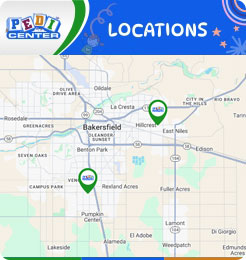What to Look for: Cat Scratch Fever Symptoms
Cat Scratch Fever, caused by a bacterial infection from a cat scratch or bite, can lead to symptoms such as swollen lymph nodes, fever, headache, and fatigue. If your child shows signs like redness, swelling, or pain around the scratch, it’s important to seek medical attention promptly. At Pedi Center Urgent Care, our team is experienced in diagnosing and treating Cat Scratch Fever. We provide the necessary treatments, including antibiotics, to help your child recover quickly. For more information, contact us or schedule an appointment online. We are conveniently located at Niles Street Bakersfield CA, and Wible Road Bakersfield CA.
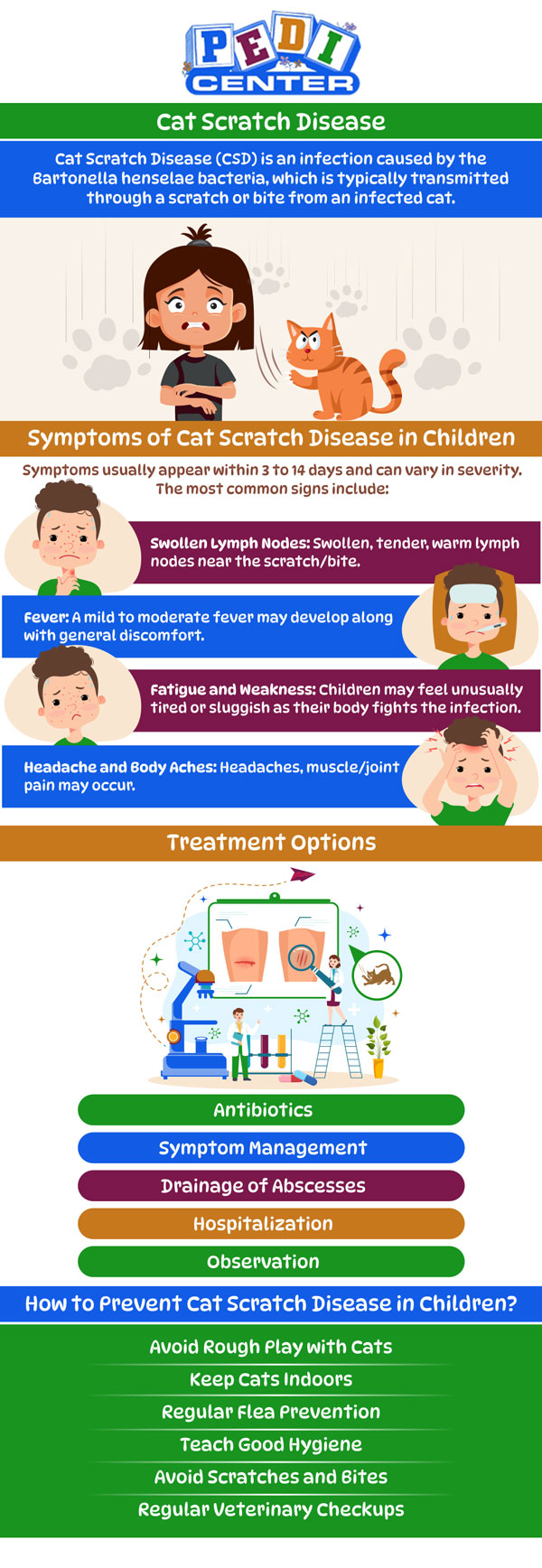
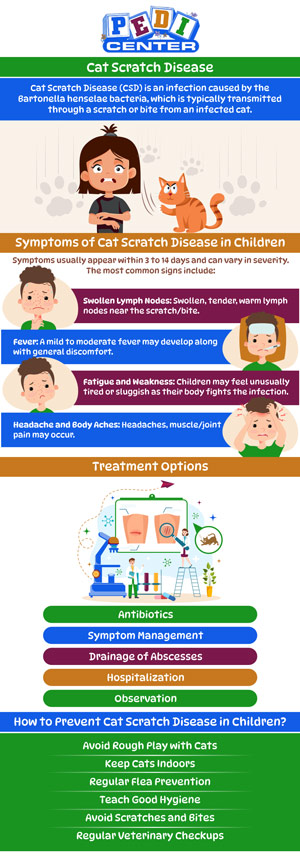
Table of Contents:
What is cat scratch fever?
What are the common symptoms of cat scratch fever?
How soon do cat scratch fever symptoms appear?
Are swollen lymph nodes a sign of cat scratch fever?
Is a bump at the site of the scratch common in cat scratch fever?
Identifying Cat Scratch Fever Symptoms at Pedi Center Urgent Care in Bakersfield, CA
At Pedi Center Urgent Care, we understand that children love pets and often come into close contact with cats and kittens. However, parents need to be aware of cat scratch fever, also known as cat scratch disease, an infection caused by the bacteria Bartonella henselae.
How Do Kids Get Cat Scratch Fever? Children typically acquire this infection through scratches, bites, or close interaction with cats, especially kittens, who can carry the bacteria even if they appear healthy.
What Symptoms Should Parents Look For? Symptoms usually develop within a few days to up to two weeks after exposure. Common signs to watch for in your child include:
● Swelling or redness at the site of the scratch or bite
● Tender or swollen lymph nodes near the affected area
● Fever, headache, fatigue, loss of appetite, and feeling generally unwell
In most cases, cat scratch fever resolves on its own. However, you should visit our urgent care facility promptly if your child’s symptoms persist or worsen, or if your child has a compromised immune system. Our pediatric providers can evaluate your child’s condition and recommend antibiotics or further treatment if necessary. Although rare, complications affecting the heart, brain, or other internal organs can occur, especially in immunocompromised children, making early evaluation important.
Prevention Tips:
● Teach your children gentle interaction with cats to avoid scratches and bites.
● Immediately wash any scratches or bites thoroughly with soap and water.
● Regularly check and treat your pets for fleas, as fleas can spread Bartonella bacteria to cats.
At Pedi Center Urgent Care, we frequently see children who’ve developed cat scratch fever, medically known as cat scratch disease—a bacterial infection caused by Bartonella henselae. Kids typically contract this infection from bites or scratches by infected cats, often kittens. Symptoms usually begin appearing within a few days to several weeks after exposure.
Parents should watch for signs such as redness, swelling, warmth, tenderness, or a small bump or blister at the site of the scratch or bite. Within one to three weeks, you may notice swollen, tender, and painful lymph nodes near the affected area. Other common symptoms in children include fever, fatigue, headache, decreased appetite, and general discomfort. Less frequently, your child may experience a sore throat, rash, joint pain, or abdominal discomfort.
In most cases, cat scratch fever is mild and resolves on its own without complications. However, if your child exhibits persistent, worsening, or unusual symptoms, it’s important to bring them in for an evaluation at Pedi Center Urgent Care. Our medical providers can properly assess your child’s condition, offer relief from symptoms, and help prevent any potential complications.
At Pedi Center Urgent Care, we understand how important your child’s health is to you. Cat scratch fever is an infection commonly seen in children who have been scratched or bitten by a cat. Typically, symptoms appear between 3 and 14 days after exposure, although in some cases, it may take several weeks for symptoms to become noticeable.
Initially, you might observe a small bump or blister at the scratch or bite site, which can later progress to swollen, painful lymph nodes nearby. Your child may also experience fever, headaches, tiredness, and loss of appetite. While cat scratch fever is often mild and resolves on its own, it’s important to monitor your child’s symptoms closely.
If your child has persistent, worsening, or concerning symptoms following contact with a cat or dog, our providers at Pedi Center Urgent Care are here to help. Our experienced pediatric team is ready to evaluate your child, provide a prompt diagnosis, and deliver appropriate treatment to get your little one feeling better quickly.
At Pedi Center Urgent Care, we frequently see children presenting with swollen lymph nodes, which can sometimes indicate cat scratch fever (also known as cat scratch disease). Cat scratch fever is an infection caused by the bacteria Bartonella henselae and is typically transmitted through scratches or bites from infected cats, with kittens being especially common carriers.
If your child develops swollen lymph nodes near the area of a recent cat scratch or bite, it may be a sign of cat scratch fever. Symptoms usually appear within one to three weeks after exposure. These lymph nodes can become enlarged, tender, and painful when touched. Additional symptoms your child might experience include fever, headache, fatigue, and loss of appetite.
Although cat scratch fever often resolves on its own, symptoms can occasionally become severe or prolonged, requiring prompt medical evaluation and care. Our pediatric healthcare providers are available to assess your child’s symptoms, provide appropriate testing, and determine the best course of treatment. If your child’s lymph nodes remain swollen or become increasingly painful following a cat scratch or bite, please visit us promptly for expert pediatric care and peace of mind.
At pediatric urgent care, we frequently evaluate and treat children who experience symptoms following a cat scratch or bite. A bump or raised lesion at the site of a cat scratch or bite is quite common and may indicate a condition known as cat scratch fever (also called cat scratch disease). This illness is caused by the bacterium Bartonella henselae, which cats can transmit to humans through scratches, bites, or even licking an open wound or broken skin.
Typically, within a few days to a couple of weeks after exposure to a cat scratch or bite, your child may develop a small raised bump, blister, or papule at the injury site. This lesion may appear red, swollen, and mildly tender and often resolves naturally within one to several weeks.
In addition to a bump at the scratch or bite site, your child may also experience other symptoms such as swollen lymph nodes (often near the affected area), fever, fatigue, headache, or loss of appetite. While cat scratch fever typically resolves on its own in healthy children, it is important to seek medical attention if your child has ongoing symptoms or discomfort. In some cases, antibiotic treatment or additional medical care may be required, especially if your child has underlying health conditions or if complications develop.
At Pedi Center Urgent Care, our pediatric specialists are trained to recognize and treat Cat Scratch Fever, an infection that can occur after a cat scratch or bite. Symptoms of this disease typically include swollen lymph nodes, fever, and fatigue, which can appear within a few days to weeks after the injury. Our team provides thorough evaluations to confirm the diagnosis and offers effective treatment options to ensure your child’s quick recovery. If your child has a persistent bump or is experiencing concerning symptoms after a cat scratch or bite, please visit Pedi Center Urgent Care. Our experienced pediatric healthcare providers are here to thoroughly evaluate your child, ensure an accurate diagnosis, and provide prompt and appropriate treatment to promote a quick and safe recovery. For more information, contact us or schedule an appointment online. We are conveniently located at Niles Street Bakersfield CA, and Wible Road Bakersfield CA. We serve patients from Bakersfield CA, Maltha CA, Kayandee CA, Burness CA, Clovis CA, Panama CA, Alameda CA, and surrounding areas.
Check Out Our 5 Star Reviews

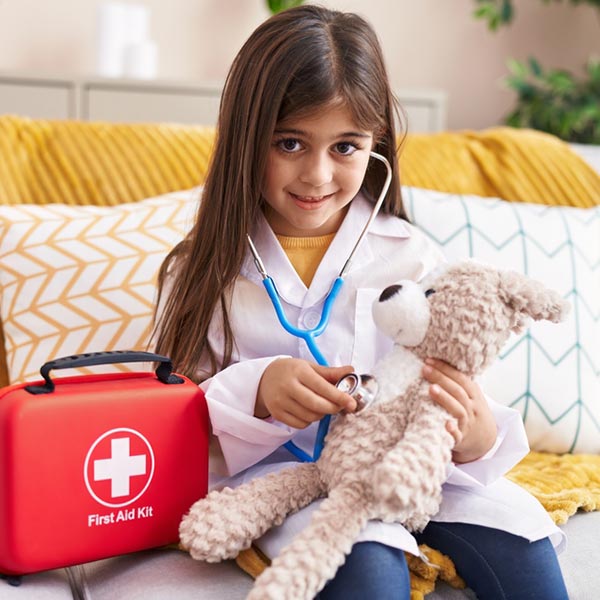
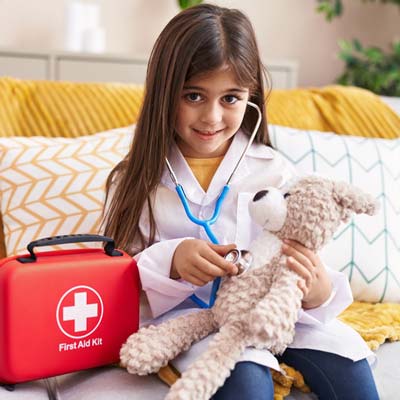
Additional Services You May Need
▸ Well-Child Visits
▸ School & Sports Physicals
▸ Immunizations
▸ Sick Visits
▸ Insect Stings
▸ Snake Bites
▸ Eye Trauma
▸ Poisons
▸ Nosebleeds
▸ Lyme Disease
▸ Animal Bites
▸ Spider Bites
▸ All Services

